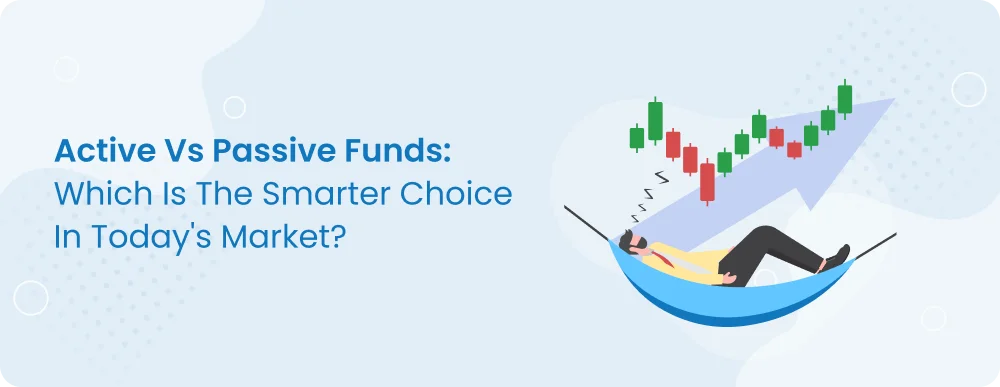Active vs. Passive Funds: Which is the Smarter Choice in Today's Market?
Noor Kaur
18 Nov 2024Tags:
Featured
Investing in mutual fund schemes can be smart for building long-term wealth, but understanding the choice between active vs passive funds is important. Each approach caters to different investor preferences and financial goals. In this blog, you'll explore the unique benefits of both active and passive investments, helping you make informed decisions that align with your financial objectives. Read along!
What are Actively Managed Portfolio & Passively Managed Portfolios?
An actively managed portfolio is guided by a professional fund manager who chooses which securities to buy, hold, or sell based on market trends, economic factors, and detailed analysis. The goal of an actively managed portfolio is to outperform a benchmark index, such as the Nifty 50 or Sensex.
On the other hand, in a passively managed portfolio, securities are chosen to mirror the performance of a specific index, like the Sensex or Nifty 50. Instead of frequent buying and selling, passive portfolio management follows a set formula, allowing the portfolio to reflect any changes in the index.
How Does Active & Passive Fund Management Work for Investors?
In active fund management, a professional manager makes investment decisions, choosing when to buy or sell assets to outperform a benchmark index. This management requires a management fee, which is included in the fund’s expense ratio.
In contrast, passive fund management aims to replicate the performance of a specific index without active intervention. Since these funds do not require constant adjustments, they incur lower operational costs, resulting in a much smaller expense ratio than actively managed funds.
Key Differences Between Active and Passive Fund Management
Here’s a breakdown of the key differences between active and passive fund management.
Pros and Cons of Active vs. Passive Fund Management Strategies
Now, let’s look at the pros and cons of active and passive funds to help you make the best decision for your portfolio management approach.
Explore Our PMS services
Pros and Cons of Active Fund Management
Some pros and cons of active fund management include:
Pros
- Active funds aim to outperform the benchmark index, offering the chance to achieve higher returns if the fund manager’s strategy is successful.
- Fund managers can choose a mix of sectors, styles, or individual stocks, allowing for a mutual fund scheme that aligns with your financial goals.
Cons
- Active funds have higher expense ratios to cover the fund manager’s expenses.
- With more frequent buying and selling, active funds can expose you to higher risks.
Pros and Cons of Passive Fund Management
The pros and cons of passive fund management include:
Pros
- Passive funds typically have much lower expense ratios than active funds, as they require minimal management.
- These funds offer returns closely aligned with the market, reducing volatility and making performance more predictable.
- Passive funds often include many stocks, giving you a more diversified portfolio.
Cons
- With passive funds, you won’t benefit from changes in market trends or opportunities outside the index.
- Passive funds won’t adapt during market downturns, potentially exposing you to short-term losses if the market underperforms.
Also Read: Market Volatility & Trend Reversals
Factors to Consider Before Choosing Active or Passive Mutual Fund Schemes
Before you invest in active vs passive mutual funds, here are some key factors to keep in mind:
- Make sure your financial objectives and investment horizon match the fund’s purpose.
- Understand your comfort level with market volatility and choose a fund accordingly.
- If you’re leaning toward passive funds, watch the tracking error. This is the difference between the fund's returns and its benchmark index.
When Should You Opt for Active Fund Management?
Choosing active fund management makes sense under certain conditions:
- If you're comfortable taking risks and believe a skilled manager can outperform the market.
- If you have specific investment goals that require tailored strategies, an active fund may align better with your needs.
Active vs. Passive Funds: Which Strategy Suits Today's Market Trends?
In an unpredictable market, actively managed funds may appeal if you aim for higher returns, as they allow fund managers to respond to market changes with tailored strategies.
On the other hand, passive funds tend to have lower costs and provide consistent performance that mirrors the broader market. This makes them a solid choice if you’re looking for steady returns without paying high management fees.
Conclusion: Active vs. Passive Funds - Making the Right Investment Choice
If you prefer a hands-on approach with the potential for higher returns and can handle the extra fees and risks, an actively managed mutual fund scheme could be a strong choice. But if you want to keep things simple, with predictable returns and minimal involvement, a passively managed fund might be better for your portfolio management strategy. Ultimately, your investor profile—your goals, risk tolerance, and budget—should guide your choice.
Calculate Your Expected Investment Returns Using Our Investment Calculator
Frequently Asked Questions
What is the difference between active and passive fund management?
Active fund management involves portfolio managers making investment decisions to outperform a benchmark, while passive management simply tracks an index or benchmark without frequent changes.
Which is better: active or passive mutual fund schemes?
Active mutual fund schemes can potentially deliver higher returns through strategic investing, but they typically come with higher fees. Passive mutual fund schemes are more cost-effective and may be less volatile, which makes them a popular choice for long-term investors.
What are the pros and cons of active vs. passive investing?
Active vs. passive investing offers unique advantages and drawbacks. Active investing aims for higher returns but can be costly and riskier. In contrast, passive investing is lower-cost with predictable returns but lacks flexibility.
Can active and passive funds be used together in a portfolio?
Yes, combining active and passive funds in a portfolio can offer a balance between potential high returns and stability. Blending both strategies within portfolio management allows investors to tailor their risk and return levels to meet specific financial goals.
Noor Kaur
18 Nov 2024Related blogs


What is SME IPOs: Meaning, Differences and How to Apply
Small and medium-sized businesses, also known as SMEs, are crucial for socioeconomic growth in many developing cou...


Evaluating Indian Sectors: Key Investment Factors | mastertrust
A few decades ago, individual investors faced the challenge of getting access to sufficient information. However, ...


India's Investment Landscape: A Comprehensive Guide | mastertrust
Investments in India have consistently outperformed those in other emerging nations.


5 secret benefits of investing in mutual fund
Investing in mutual funds is a strategic move. From diversification of funds to long-term growth, the possibilitie...
Sign up to our newsletter !
Share this article on
Recent articles
Tags:
Open a Demat Account in just 15 minutes !

Click on open
account below

Fill out some
basic details

Upload your
documents

Start trading in
24 Hours *
Commonly asked questions
Is Master Capital Services Limited SEBI registered?
Do you have a mobile app for Trading and Finance Management?
What services does mastertrust provide?
What is the minimum investment required to start trading with your company?
Is my personal and financial information secure with your company?
What is your customer support availability?

